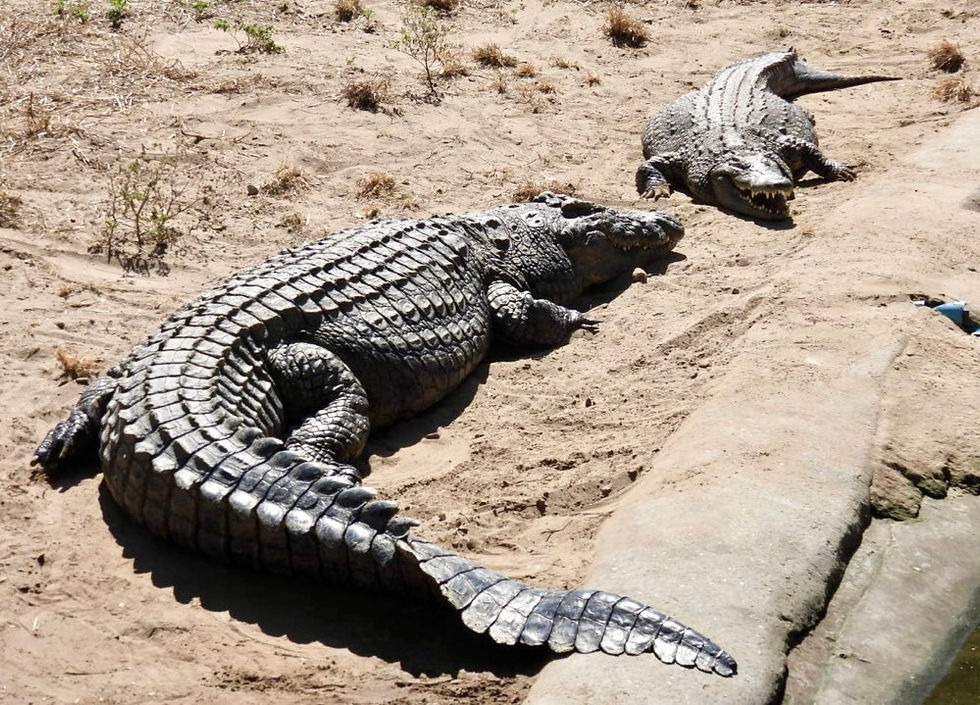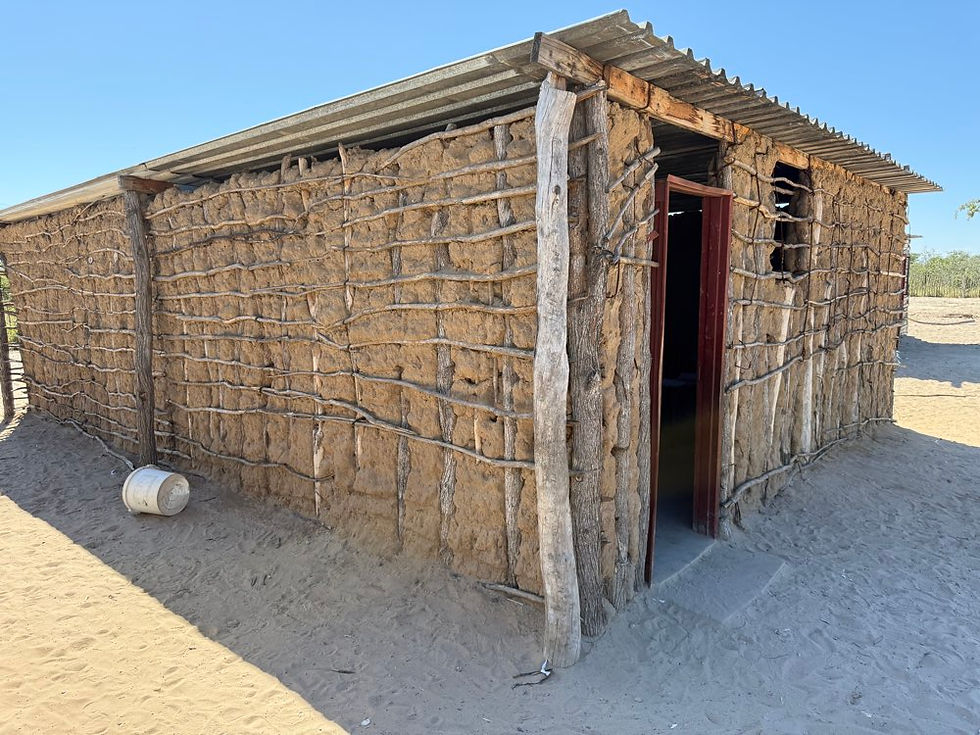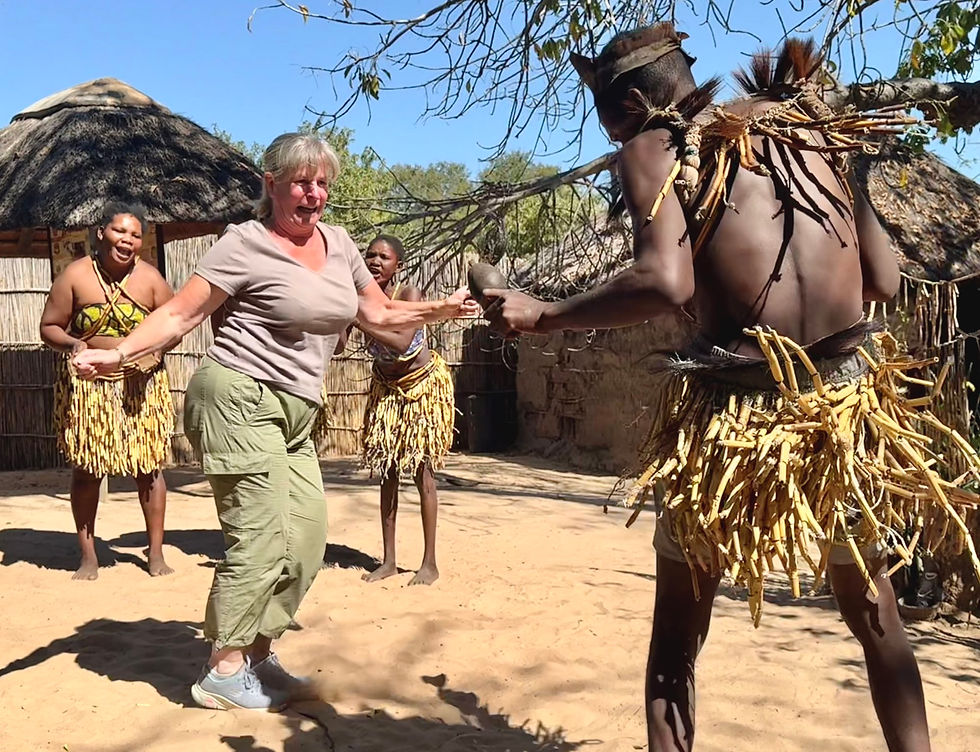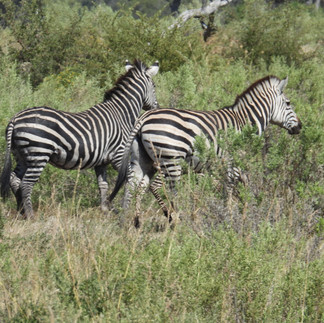7: Tales Of The Riverbank
- nick4555
- May 31
- 8 min read
This weeks blog has had a very watery theme,as we've spent time in the Okavango Panhandle area in the north of Botswana; on the shores of the Kavango River (they don't use the 'O' in Namibia) and on the banks of the Zambezi looking across from Namibia to Zambia.


Last weeks blog saw us bidding farewell to Claire and Jonathan. We stayed on at Drotsky's Campsite and explored the local area for a few more days.
This area is less busy with tourists than the Delta in the south, but it is charming in its own right; the lack of tourist hordes is a plus as far as we are concerned.

Drotsky's is known for its prolific bird life, and whilst not 'twitchers', we decide to take a boat trip up river with an extremely knowledgeable guide. We see a wide variety of birds including the Bank Swallows (we know them as Sand Martins in the UK) who make their nests in deep holes that the males dig into the riverbank.


The bird life here is wonderfully diverse, among the many varieties we see are the White-Throated Bee-eater, the noisy Hadeda Ibis, the Lilac-breasted Roller (apparently one of the most colourful birds in the world) and many Pied Kingfishers - busily hovering and swooping into the river to catch some poor unsuspecting fish.
The excitement isn't all avian-based, we have several close encounters with some big old crocodiles who stare at us with their emotionless eyes.

Then it's time for the obligatory sundowner, before returning to base!


The Krokovango Crocodile Farm isn't something that floats Janette's boat but it's nearby and Nick's keen, so we pay a visit.

Call her squeamish if you like but Janette finds the sight (and smell) of thousands of crocodiles being bred to be killed mainly for their skins to be really quite horrible. Some of the crocodile meat - the tails - is sold for human consumption but the rest is fed to the other crocodiles which just seems wrong. Crocodiles have been known to eat each other in the wild but it isn't a common practice.


The adult crocodiles who are kept for breeding are less challenging to view. They are out in the open with big pools to swim in and as they bask in the sun, they don't seem discontented.

Some of the adult crocodiles have been placed here for their own safety after either attacking and eating humans or livestock. One such miscreant is Sam who is immense - measuring 16 feet in length!

There's also a photo on display of a real bruiser who was dispatched after causing havoc in the local area.


We venture away from the river a little to see the rock paintings at Tsodilo. This is a UNESCO World Heritage Site where there is extensive rock art - over 4.500 paintings have been discovered in 400 locations so far. These hills have been inhabited by humans for over 100,000 years; some of the rock art dates back to the Stone Age whilst other examples are from the 19th century.

This area is also sacred to the San people who believe that it is the birthplace of life. It is still a place of prayer and pilgrimage to this day.

The images vary in style and artistic talent. There is one image of a penguin and a couple of images of whale - this is astonishing given the age of the paintings and the fact that Tsodilo is many miles away from any coast. This tells us that these ancient people travelled very great distances and recorded the wonders that they had seen to share with others.


The journey back to the Botswana/Namibia border is interesting in that although the communities on either side live only a few miles apart, their ways of life seem quite distinct from each other - with the Botswana side having a more rural, subsistence farming feel to it than the area on the other side of the border.



Back into Namibia we camp on the banks of the Kavango River, it's idyllic.........


......but we have to say, the toilets are a bit of a surprise!



We spend some time planning the next few days of our journey and then take a boat trip to see the nearby Popa Falls and the resident hippo families downriver.


The Popa Falls are more of a series of wide rapids than a cascade but they're impressive just the same.

The hippos put on a fine display for us.......

.....this one looks as if a visit to the dentist may be in order!

Janette wakes up in the middle of the night as there is a rustling noise outside, she looks out and is treated to the sight of a hippo contentedly grazing right outside the tent. She wakes Nick, who decides to dangle down head first to take this photo.........it's a 'what could possibly go wrong?' moment!


We're travelling through the Caprivi Strip which is a narrow strip of land sandwiched between Botswana and Angola but belonging to Namibia. It was officially re-named the Zambezi Region in 2013 as Caprivi has colonial connotations; that said, we didn't come across a single person who referred to it by anything other than its former name - old habits die hard.
The area edging the road is fairly continuously populated for many miles which is unusual for the Namibia we have seen so far, we put this down to the population being squeezed into a relatively small area.

We stop and get chatting to some school children and their teacher and we are invited into their school - Shamakwi Primary School. There are 134 students here and the teacher points out that the facilities aren't great. There are no toilets and of the four classrooms, only one is of modern construction; the others are built of either corrugated metal (which becomes unusable in the intense heat of the summer) or traditional mud and stick.

The children attending this school come from a very remote rural area and opportunities post-school are limited. The teacher explains to us that she tries to instil hope and aspirations in her pupils but she is also aware of the challenges they will face when they leave school.

The main road takes us through Bwabwata National Park but we have other ideas. This park is little-visited and we decide to take ourselves on a detour down the overgrown track that leads off into the park's interior.
Things start well and we see a couple of giraffe almost immediately but then nothing at all for ages. The track is clearly hardly ever used and it crosses our minds that if we break down here it'll be a mighty long wait before anyone comes along and finds us.
To be truthful, we're feeling a bit discouraged and then, as is the way with wildlife spotting, everything changes in a moment. We find ourselves right in the middle of a herd of 16 elephants!

It's really thrilling, we sit and watch them for some time - just us and them, it's magical. One large female bashes a tree with her head to dislodge the fruit that she then hoovers up - ingenious!


It's time for some housekeeping at our next stop. A good thing about this sunny and dry climate is that everything is dry in no time.

We head off on another boat trip, but this time we are negotiating very narrow, shallow channels. There are very few visitors to this area. We share the trip with a very nice couple from South Africa who are travelling around like us.




More hippos and crocs are spotted as well as a type of ground lizard - over a metre long - who is brave (or foolish) enough to steal and eat crocodile eggs - a perilous pursuit to say the least!

On our way to a coffee stop we come across a 'Traditional Village' museum; these museums are always concealed behind fences so that all that can be seen from the outside are the roofs of the rondavels - all very tantalising and we take the bait, pay the entrance fee and are admitted to the inner sanctum.

A colossal baobab tree dominates the centre of the compound, it is really something to see and we are told that it is about 2,000 years old! Baobab trees are vital to life in these arid regions, they can store water in their trunks (which are hollow) and this enables them to continue to produce fruit even in harsh droughts.
The fruit of the baobab is a true superfood, containing six times more vitamin C than oranges and six times more potassium than bananas. The fruit, leaves, bark and seeds have all been used in traditional medicine for centuries. Baobab oil is also great for skin and haircare.

Of course, this 'traditional village' is nothing of the sort. it's a construct to allow tourists like us to see how things were done in the past. The 'villagers' are local people playing a part and dressed in traditional costume as part of their role.
A guide shows us around and we look at how metal arrow tips were forged, how baskets were woven, how houses were built and how special occasions were celebrated.
If you can accept that this is a show put on for tourists then you can engage with the experience and really learn from it about how things were done in the past.



Janette gives it her all as you can see. Nick suggests that he would be willing to exchange this keen new recruit for three goats, but his kind offer was declined! We come away having had fun and having learned a lot.
We're now deep into the Caprivi Strip in an area of Namibia that juts down into Botswana, it's remote and we are staying in a community camp that is miles and miles off the beaten track down some very sandy 4x4 tracks that are quite challenging to drive along.
This is Livingstone country, Dr. Livingstone spent time in this area in the mid-1800s, he befriended the local Makololo chief and noted in his journal that he had found 'The Garden of Eden'. It is from here that he began his campaign for the abolition of slavery.



Part of this area is now a National Park and we give it a whirl. As national parks go it's very small, only 320 square kilometres. This park which is unfenced, provides a link for the migration of elephants from Botswana, through Namibia to Angola. Although the animals can come and go as they please, it plays host to many of the big names as well as rare antelope and birds.

We visit the 'Lonely Baobab' tree to give it a bit of company and then at a waterhole we're treated to the sight of a huge number of hippos, many of whom look as if they are grazing - but on closer inspection are just standing motionless resting their heads on the ground!

We don't see any other big animals but the park is really picturesque and there are plenty of smaller animals that interest us. A big plus for us is the lack of other people, we can go at our own pace and enjoy sitting and watching the animals without anyone else around.
For now, our riverbank odyssey comes to an end beside the Zambezi. Nick pours Janette a large glass of wine and carefully positions her where he hopes she won't notice the sign - while he nips back to Rocky to check the life insurance policy - how gallant!
Janette, oblivious to the imminent danger enjoys her book and the view across the Zambezi towards Zambia on the opposite bank; our last evening in Namibia for a while as we make our way towards Zimbabwe.









































Enjoyed binge reading your first 7 weeks - it really is quite the adventure x
Great to hear your news - for some reason we haven’t been getting previous updates but it has been fun reading parts 1-6 together! Wonderful photos and it sounds like great fun! Hope you (and Rocky) are still in good shape and look forward to catching up on your return.